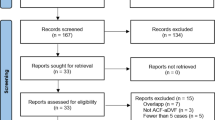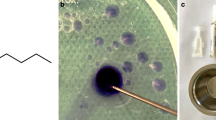Abstract
Background
Sinus pericranii (SP) is a rare venous anomaly involving an abnormal connection of the intracranial dural sinuses with the extracranial veins. Magnetic resonance (MR) imaging (MRI) with MR venography can detect the typically congested intra- and extracranial venous components of SP.
Clinical presentation
We report a rare case of lateral SP associated with the superior sagittal sinus, which might had already developed almost total thrombosis of the SP at the first MRI. As this patient had not presented with classical manifestations of SP on clinical or neuroradiological findings, the initial diagnosis of SP was difficult. Repeated MRI revealed dynamic morphological changes associated with reperfusion of the thrombosed SP via the cortical vein.
Conclusion
MR venography combined with gadolinium enhancement was useful for diagnosis of the SP with an extremely slow flow status.




Similar content being viewed by others
References
Akram H, Prezerakos G, Haliasos N, O’Donovan D, Low H (2012) Sinus pericranii: an overview and literature review of a rare cranial venous anomaly (a review of the existing literature with case examples). Neurosurg Rev 35:15–26
Azusawa H, Ozaki Y, Shindoh N, Sumi Y (2000) Usefulness of MR venography in diagnosing sinus pericranii: case report. Radiat Med 18:249–252
Bigot J-L, Iacona C, Lepreux A, Dhellemmes P, Motte J, Gomes H (2000) Sinus pericranii: advantages of MR imaging. Pediatr Radiol 30:710–712
Bouali S, Maatar N, Ghedira K, Boubaker A, Jemel H (2017) Spontaneous involution of a sinus pericranii. Child Nerv Syst 33:1435–1437
Carpenter JS, Rosen CL, Bailes JE, Gailoud P (2004) Sinus pericranii: clinical and imaging findings in two cases of spontaneous partial thrombosis. AJNR Am J Neuroradiol 25:121–125
Gandolfo C, Krings T, Alvarez H, Ozanne A, Schaaf M, Baccin CF, Zhao W-N, Lasjaunias P (2007) Sinus pericranii: diagnostic and therapeutic considerations in 15 patients. Neuroradiology 49:505–514
Marras C, McEvoy AW, Grieve JP, Jager HR, Kitchen ND, Villani RM (2001) Giant temporo-occipital sinus pericranii: a case report. J Neurosurg Sci 45:103–109
Pavanello M, Melloni I, Antichi E, Severino M, Ravegnani M, Piatelli G, Cama A, Rossi A, Gandolfo C (2015) Sinus pericranii: diagnosis and management in 21 pediatric patients. J Neurosurg Pediatr 15:60–70
Rozen WM, Joseph S, Lo PA (2008) Spontaneous involution of two sinus pericranii: a unique case and review of the literature. J Clin Neurosci 15:833–835
Sanders FH, Edwards BA, Fusco M, Oskouian RJ, Tubbs RS, Johnston JM (2017) Extremely large sinus pericranii with involvement of the torcular and associated with Crouzon’s syndrome. Childs Nerv Syst 33:1445–1449
Sheu M, Fauteux G, Chang H, Taylor W, Stopa E, Robinson-Bostom L (2002) Sinus pericranii: dermatologic considerations and literature review. J Am Acad Dermatol 46:934–941
Shimonin A, Martinerie S, Levivier M, Daniel RT (2017) Three-dimensional printing of a sinus pericranii model: technical note. Childs Nerv Syst 33:499–502
Spektor S, Weinberger G, Constantini S, Gomori JM, Beni-Adani L (1998) Giant lateral sinus pericranii. Case report. J Neurosurg 88:145–147
Wakisaka S, Okuda S, Soejima T, Tsukamoto Y (1983) Sinus pericranii. Surg Neurol 19:291–298
Wen C-S, Chang Y-L, Wang H, Kuo M-F, Tu Y-K (2005) Sinus pericranii: from gross and neuroimaging findings to different pathophysiological changes. Childs Nerv Syst 21:482–488
Acknowledgements
We thank Mr. Joji Hashimoto for providing an excellent 3D-reconstructed images and Edanz Group (www.edanzediting.com/ac) for editing a draft of this manuscript. This work was supported by Research Foundation of Fukuoka Children’s Hospital.
Author information
Authors and Affiliations
Corresponding author
Ethics declarations
Conflict of interest
The authors declare that they have no conflict of interest.
Rights and permissions
About this article
Cite this article
Ryorin, M., Morioka, T., Murakami, N. et al. Dynamic morphological changes of thrombosed lateral sinus pericranii revealed by serial magnetic resonance images. Childs Nerv Syst 34, 143–148 (2018). https://doi.org/10.1007/s00381-017-3592-x
Received:
Accepted:
Published:
Issue Date:
DOI: https://doi.org/10.1007/s00381-017-3592-x




